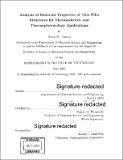Analysis of materials properties of thin film structures for thermoelectric and thermophotovoltaic applications
Author(s)
Baum, Brian K
DownloadFull printable version (4.219Mb)
Other Contributors
Massachusetts Institute of Technology. Department of Materials Science and Engineering.
Advisor
Eugene A. Fitzgerald.
Terms of use
Metadata
Show full item recordAbstract
Metal-organic chemical vapor deposition (MOCVD) was used to grow InAsP graded layers and AlAs/GaAs superlattices for materials studies related to thermophotovoltaics and thermoelectrics respectively. High resolution x-ray diffraction (HRXRD) was used to determine the As concentration in each of the InAsP layers. Arsenic concentration was found to vary linearly with the percentage of AsH3 in the reactive gas flow up to 60 % deposited, and had an asymptotic relationship for higher incorporated concentrations. Higher growth temperatures reduced As incorporation. Transmission electron microscopy (TEM) images were used to determine layer thicknesses. The growth rate of InAsP layers was found to be independent of growth temperature and the percentage of As. Superlattice samples with 0 %, 5 %, 10 %, and 20 % variations in the superlattice period were grown via MOCVD and analyzed using HRXRD. The intensities of the satellite peaks were found to decrease and broaden with increasing variation in the period length and disappeared completely in samples with up to 10 % variation. Thermal conductivity measurements performed using an optical pump-probe technique showed lower thermal conductivities for samples with greater variation. The irregularity of the superlattice period is believed to enhance the structure's ability to impede phonon propagation.
Description
Thesis: S.B., Massachusetts Institute of Technology, Department of Materials Science and Engineering, 2010. Cataloged from PDF version of thesis. Includes bibliographical references (pages 45-46).
Date issued
2010Department
Massachusetts Institute of Technology. Department of Materials Science and EngineeringPublisher
Massachusetts Institute of Technology
Keywords
Materials Science and Engineering.